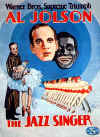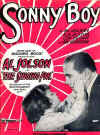Jolson 101
Al Jolson Biography - Part III
by John Kenrick
(Copyright 2004)
(All the photos on this page are thumbnail images – click on them to see larger versions.)
Second Marriage: Ethel Delmar
While the tour of Bombo was on its summer break in July of 1922, Jolson wooed and married Ethel Delmar. A chorus girl in George White's Scandals, Ethel's looks and fun loving personality supposedly captivated Jolson at first sight. Soon after the wedding, she found herself being ignored and abandoned for weeks at a time – a perfect echo of Jolson's first marriage. Ethel drowned her sorrows in bootleg booze. Occasionally, Jolson tried to reach out to her, but these attempts were halfhearted. His attentions were, as usual, focused on his audiences.
 The
program title page for Big Boy (1925), the
last of Jolson's Winter Garden musicals.
The
program title page for Big Boy (1925), the
last of Jolson's Winter Garden musicals.
Big Boy (1925 - 48) brought Jolson back to the Winter Garden, with the inevitable Gus as a jockey who must win races despite an assortment of racetrack shenanigans. He received incomparable reviews, including this often quoted accolade offered by Robert Benchley in the original version of Life magazine –
"To sit and feel the lift of Jolson's personality is to know what the coiners of the word 'personality' meant. Unimpressive as the comparison may be to Mr. Jolson, we should say that John the Baptist was the last man to possess such a power. There is something supernatural back of it, or we miss our guess. When Jolson enters, it is as if an electric current had been run along the wires under the seats where the hats are stuck. The house comes to tumultuous attention. He speaks, rolls his eyes, compresses his lips, and it is all over. You are a life ember of the Al Jolson association. He trembles his under lip, and your heart breaks with a loud snap. He sings, and you totter out to send a night letter to your mother. Such a giving-off of vitality, personality, charm, and whatever all those words are."
- quoted in Goldman, Jolson: The Legend Comes to Life, p. 136.
A recurring case of bronchitis kept forcing Jolson to cancel performances, and the Shuberts were forced to close their sold-out show after eight weeks. Few would have believed it, but Jolson would never appear at the Winter Garden again.
Jolson recuperated on an extended cruise, where he alternated between ignoring his wife Ethel and wondering why she kept on drinking. On their return to New York in August 1925, he reopened Big Boy for another 120 performances, followed by an eleven month tour. Jolson added "Keep Smiling At Trouble" and "It All Depends on You." When audiences did not respond to "If You Knew Susie," he offered it to friend (and competitor) Eddie Cantor. It became one Cantor's greatest successes, and years later Al told Eddie, "If I knew it was that good, you dog, I'd never have given it to you!"
In the summer of 1926, Al took Ethel to Europe to obtain a quick divorce. As before, he made occasional attempts to reconcile with Ethel, to no avail. Her drinking became progressively worse, and by the 1930s Ethel had to be committed to a series of nursing facilities. She lived until 1976, her expenses covered by the Jolson estate.
Jolson On Screen
 The
original 1927 souvenir program for
The Jazz Singer.
The
original 1927 souvenir program for
The Jazz Singer.
Jolson had made several appearances on the silent screen, but none had proved satisfactory to Al or his fans. A short 1926 sound film for Warner Brothers had him in blackface singing several of his hits. Although the brief film caused no particular sensation, Warner executives remembered him when they obtained screen rights to The Jazz Singer (1927), a short story that had succeeded when adapted for Broadway. The saga of stage singer Jack Robin rising to stardom despite the disapproval of his traditionalist cantor father was an obvious fit for Jolson. The Warner Studio desperately needed a money-maker. When stage star George Jessel demanded a high salary for the film version, the studio decided to hire the more popular Jolson – who had no qualms about stealing a plum part from a longtime friend.
Filmed in Los Angeles in the late summer of 1927, The Jazz Singer was customized to fit Jolson's talents. The original intention was to only use sound for several song sequences, but Jolson changed that by improvising dialogue. His spontaneous asides to the audience in a cabaret scene proved so exciting that it was decided to add audible dialogue in a scene with his mother. Al seats actress Eugenie Besserer on his knee, and her uncertain reactions makes it reasonable to assume his words were improvised. After a few minutes of charming banter, Jolson sings Irving Berlin's "Blue Skies," but is cut short when his father appears and orders him to stop. Later on, the title character is seen achieving Broadway stardom in scenes partially filmed in the Winter Garden.
Jolson's sound scenes (he's the only one who really talks or sings) are the liveliest moments in an otherwise tedious film. But no one had ever seen or heard anything like this on screen. When The Jazz Singer debuted in October 1927, it signaled the end of the silent film era. Within months, movie audiences wanted nothing but sound films, no matter how mediocre. Talking movies were all the rage, and Al Jolson was the form's first star.
Since films paid far more than Broadway for far less effort, Jolson did not hesitate to relocate to California and devote himself full time to screen work.
 On the original sheet music
cover for "Sonny Boy," young Davey Lee helps Al Jolson pull out all
the sentimental stops in the blockbuster 1928 screen hit
The Singing Fool.
On the original sheet music
cover for "Sonny Boy," young Davey Lee helps Al Jolson pull out all
the sentimental stops in the blockbuster 1928 screen hit
The Singing Fool.
In The Singing Fool (1928), Jolson played a show biz vocalist whose wife runs off, taking their beloved son. When the boy becomes dangerously ill, the vocalist arrives just in time to see his child die. The score included "I'm Sitting on Top of the World" and "There's a Rainbow 'Round My Shoulder," but the real hit of the film was Jolson's tear-jerking rendition of "Sonny Boy."
Songwriters Buddy DeSylva, Ray Henderson and Lew Brown concocted the maudlin "Sonny Boy" as a joke, but Jolson realized it was just the sort of thing his audiences would love. The song and the partially silent Singing Fool both seem corny today, but Jolson's recording of "Sonny Boy" became the first ever to sell more than a million copies, and the film smashed box office records. Although some might argue with Jolson's billing as "The World's Greatest Entertainer," there is no question that in 1928 he was the world's most popular.
Third Marriage: Ruby Keeler
Jolson was the hottest property in show business in 1928. That's when he met and fell for Ruby Keeler, a nineteen year old chorus dancer at Texas Guinan's Manhattan speakeasy. Jolson was more than twice her age, and she was already romantically involved with mobster Johnny "Irish" Costello. But as before, Jolson launched a relentless romantic offensive, showering Ruby with gifts and attention. After Jolson gave Ruby a pre-wedding gift of one million dollars, her Irish Catholic family dropped all objections, as did Costello. Al and Ruby were married in September 1928 and honeymooned in Europe. Although Al assured reporters, "This is for keeps" he promptly started mistreating Ruby just as he had his previous wives.
Ruby had been raised on the streets of New York, and was not one to quietly put up with Al's sometimes dismissive, sometimes abusive attitude. Unlike his other wives, Ruby also had a career of her own. So long as that career provided her with sufficient distraction, Ruby would endure the strain of being Mrs. Jolson.
Al tended to show plenty of interest in Ruby whenever it suited his insatiable desire for publicity. When Florenz Ziegfeld invited Keeler to star in the Broadway musical Show Girl (1929 - 111), Jolson insisted that she accept. Knowing her talents were limited, Keeler was terrified. At the first pre-Broadway performance in Boston, she was dancing to the Gershwin showstopper "Liza" when Al unexpectedly stood up in the audience and started singing it. The audience, thinking that Jolson was encouraging his young wife, roared its approval. Ziegfeld made the most of the situation by convincing Al to repeat the stunt during the show's first week in New York.
The resulting avalanche of publicity helped the poorly received show sell tickets. Soon afterward, Ruby suffered an injury or illness (sources differ) and withdrew from the show. Ziegfeld tried to carry on with an understudy in the lead, but was soon forced to close the show – the first in a series of costly failures that led to his bankruptcy a few years later.
Audience tastes were changing, but Warner Brothers kept Jolson doing the same thing in film after film. Jolson made Say It With Songs (1929) into yet another sentimental sob-fest. By the time he starred in the syrupy Mammy (1930) and the clumsy screen version of Big Boy (1930), his reign as a top Hollywood star was already over.
